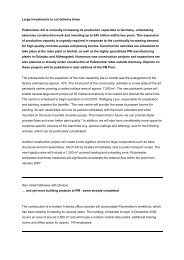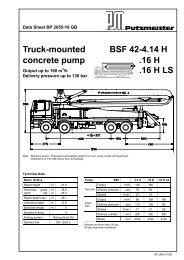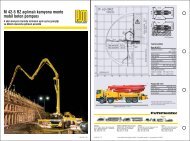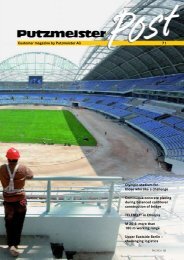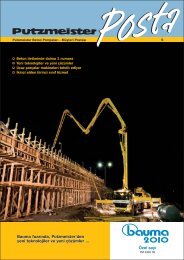High-rise pumping at the Burj Dubai at over 400 bar ... - Putzmeister
High-rise pumping at the Burj Dubai at over 400 bar ... - Putzmeister
High-rise pumping at the Burj Dubai at over 400 bar ... - Putzmeister
- No tags were found...
Create successful ePaper yourself
Turn your PDF publications into a flip-book with our unique Google optimized e-Paper software.
Site report<strong>High</strong>-<strong>rise</strong> <strong>pumping</strong> <strong>at</strong> <strong>the</strong> <strong>Burj</strong> <strong>Dubai</strong><strong>at</strong> <strong>over</strong> <strong>400</strong> <strong>bar</strong> delivery pressureMXR 32-4 T3 x MXR 28-4 T1With several <strong>Putzmeister</strong> high performanceconcrete pumps, a sophistic<strong>at</strong>eddelivery line system, nonballastedst<strong>at</strong>ionary booms and demandingconcrete mixtures, <strong>the</strong>carcass of <strong>the</strong> <strong>Burj</strong> <strong>Dubai</strong> is currentlyunder construction. The constructor, Emaar Properties (UAE), hascommissioned a consortium managedby Samsung (Korea) toge<strong>the</strong>rwith BeSix (Belgium) and Arabtec(UAE) with carrying out <strong>the</strong> constructionworks on <strong>the</strong> prestigioushigh-<strong>rise</strong> project.Turner Construction (USA) is responsiblefor <strong>the</strong> project management.The building with a finalhight of approx. 800 m, will be <strong>the</strong>highest building in <strong>the</strong> world. It hasnot only fascin<strong>at</strong>ed intern<strong>at</strong>ionalexperts since <strong>the</strong> start of construction(excav<strong>at</strong>ion in August 2004), butalso a wide public.3 x BSA 1<strong>400</strong>0A proper amount of trust in <strong>the</strong> knowhowand reliability of <strong>the</strong> partner wasrequired when Unimix – responsible forconcrete production and delivery <strong>at</strong> <strong>the</strong><strong>Burj</strong> <strong>Dubai</strong> – decided to commission<strong>Putzmeister</strong> AG with <strong>the</strong> supply andinstall<strong>at</strong>ion of <strong>the</strong> pumps and boomsystems. <strong>Putzmeister</strong> had already ascertainedby <strong>pumping</strong> tests, th<strong>at</strong> <strong>the</strong> concretepumps and pipelines were suitable fordelivery heights up to 570 m with apump output of around 30 m 3 /h. For st<strong>at</strong>icreasons, <strong>the</strong> building section toweringabove this should consist of a steel construction.The <strong>Burj</strong> <strong>Dubai</strong> <strong>at</strong> a construction height of around <strong>400</strong> mBP 3893 GB
<strong>High</strong>-<strong>rise</strong> <strong>pumping</strong> simul<strong>at</strong>ed inextensive preliminary testsPM's prepar<strong>at</strong>ions <strong>at</strong> <strong>the</strong> start of 2005were correspondingly thorough as wellas extremely time-consuming andhuman-resource intensive, both <strong>at</strong> <strong>the</strong>Aichtal Works and <strong>at</strong> <strong>the</strong> constructionsite in <strong>Dubai</strong>. On site, extensive testswere carried out in a large test series withhorizontally placed pipelines in order tosimul<strong>at</strong>e <strong>the</strong> pressure behaviour andexpected friction of <strong>the</strong> concrete basedon <strong>the</strong> l<strong>at</strong>er mixture in <strong>the</strong> line and toconvert it to high-<strong>rise</strong> <strong>pumping</strong>. Thetests were carried out using a series producedBSA 1<strong>400</strong>0 HP D high-<strong>rise</strong> pumpand ZX delivery line (DN 125).In <strong>the</strong> meantime, <strong>the</strong> base pl<strong>at</strong>e for <strong>the</strong>tower and <strong>the</strong> three tower wings was producedby truck-mounted concrete pumpswith different boom reaches. The 7,000 m 2found<strong>at</strong>ion is supported on 200 concretepiles (diameter 1.5 m) running 50 m deepfor <strong>the</strong> actual tower, and on around 650pl<strong>at</strong>form piles (diameter 0.9 m) running36 m deep for <strong>the</strong> wings. In total, 45,000m 3 of concrete was laid <strong>at</strong> <strong>the</strong> <strong>Burj</strong> <strong>Dubai</strong>for <strong>the</strong> found<strong>at</strong>ion, including base pl<strong>at</strong>e.Super high pressure pumps adaptedto <strong>the</strong> extreme conditionsIn <strong>the</strong> <strong>Putzmeister</strong> Aichtal Works, <strong>the</strong>details of <strong>the</strong> new super high pressurepump to be developed were already fixed<strong>at</strong> this time. It had to be constructed anddelivered by summer 2005 for <strong>the</strong> imminenthigh-<strong>rise</strong> <strong>pumping</strong>. With <strong>the</strong> BSA1<strong>400</strong>0 SHP D – <strong>the</strong> correct name forextreme pumps – <strong>the</strong> frame and hopperhave been reinforced to be able to withstand<strong>the</strong> enormous forces. The S transfertube and S transfer tube bearingshave also been adjusted in respect of <strong>the</strong>expected pressures. To minimize contamin<strong>at</strong>ionof <strong>the</strong> hydraulic fluid withw<strong>at</strong>er or dirt particles from <strong>the</strong> outset, <strong>the</strong>BSA 1<strong>400</strong>0 SHP D also has a particularlyeffective filter system. Above all, however,<strong>Putzmeister</strong> engineers have modified<strong>the</strong> drive hydraulics so th<strong>at</strong> <strong>the</strong> transl<strong>at</strong>ionr<strong>at</strong>io between <strong>the</strong> hydraulic and <strong>the</strong>concrete pressure is less than i = 1 withpiston side oper<strong>at</strong>ion. Due to thishydraulic r<strong>at</strong>io concrete pressures of<strong>over</strong> <strong>400</strong> <strong>bar</strong> (max./<strong>the</strong>or.) are possiblewith <strong>the</strong> high performance pumps. Becauseof <strong>the</strong> expected demands for <strong>the</strong><strong>Burj</strong> <strong>Dubai</strong> project <strong>the</strong> conveying pressureof <strong>the</strong> pump system was limited. Thesuper high pressure pumps are driven bya standard, 470 kW C<strong>at</strong>erpillar dieselengine, which is also integr<strong>at</strong>ed in o<strong>the</strong>rBSA concrete pumps.Checking <strong>the</strong> slump during <strong>the</strong> trials3 4Overview of <strong>the</strong> layout of <strong>the</strong> delivery lines <strong>at</strong> <strong>the</strong> pump st<strong>at</strong>ion – <strong>the</strong> two super high pressureBSA 1<strong>400</strong>0 SHP D pumps are shown on <strong>the</strong> left and rightTo simul<strong>at</strong>e high-<strong>rise</strong> concrete delivery under extreme conditions, hundreds of metres of delivery line were first laid horizontally, measurement values andfactors such as friction coefficients were determined and converted to high-<strong>rise</strong> <strong>pumping</strong>.2Unimix has combined two of <strong>the</strong>se superhigh pressure BSA 1<strong>400</strong>0 SHP D pumpsand <strong>the</strong> "normal" BSA 1<strong>400</strong>0 HP D highpressure concrete pump from <strong>the</strong> testphase to form one pump st<strong>at</strong>ion. Themachines are around 70 m from <strong>the</strong> centreof <strong>the</strong> building tower.<strong>High</strong>-strength concretes requirepressure reservesTo keep <strong>the</strong> measurements of <strong>the</strong> ceilingsand supporting walls as low as possible,and to be able to carry <strong>the</strong> increasingloads as height <strong>rise</strong>s, only concretes withhigh compressive strength are beingused on <strong>Dubai</strong>'s most spectacular high<strong>rise</strong>construction site. According to <strong>the</strong>original plans, <strong>the</strong> distribution of <strong>the</strong>individual concrete mixture breakdownslooked as follows:■ Base pl<strong>at</strong>e: C80A (maximum particlesize 20 mm)■ Up to level 26 (height 95 m) for <strong>the</strong>walls: C80A (maximum particle size20 mm)■ Up to level 126 (height 452 m) for <strong>the</strong>walls: C80 (maximum particle size14 mm)■ Up to level 154 (height 570 m) for <strong>the</strong>walls: C60■ Concrete with compressive strengthC50 is compulsory for cre<strong>at</strong>ing <strong>the</strong>ceilings of all storeys.Although concrete class C80A with 20mm maximum particle size was originallyonly intended for install<strong>at</strong>ion up to 95m height (level 26), this concrete waspumped with 50 cm spread and a w/cvalue of 0.3 to a height of 352 m (level100) with a slightly modified mixturebreakdown. For this height and with thism<strong>at</strong>erial, <strong>the</strong> delivery pressure for rod sideoper<strong>at</strong>ion was just approx. 150 <strong>bar</strong> <strong>at</strong>30 m 3 /h. There were two crucial reasonsfor keeping <strong>the</strong> mixture: On <strong>the</strong> one hand,all those responsible were pleasantlysurp<strong>rise</strong>d <strong>at</strong> how easily this m<strong>at</strong>erialcould be pumped even beyond <strong>the</strong> 300 mmark. On <strong>the</strong> o<strong>the</strong>r hand, <strong>the</strong>re were clearcost advantages. This is because significantlyless cement and fines are requiredfor concrete with a maximum particlesize of 20 mm than for a concrete mixturewith a maximum aggreg<strong>at</strong>e particle sizeof 14 mm. Each line is also pumped with2 m 3 grout, which is received <strong>at</strong> <strong>the</strong> top of<strong>the</strong> building in a container and can bedumped to <strong>the</strong> floor team with a crane.Time-consuming mountingof <strong>the</strong> pump linesDeveloping efficient concrete <strong>pumping</strong>for <strong>the</strong> spectacular delivery height <strong>at</strong> <strong>the</strong><strong>Burj</strong> <strong>Dubai</strong> was just one of <strong>the</strong> manytasks for <strong>Putzmeister</strong> engineers. A particularchallenge was <strong>the</strong> delivery linesystem, its wear behaviour and its compressivestrength as well as <strong>the</strong> line routingand mounting in <strong>the</strong> structure.<strong>Putzmeister</strong> applied for several p<strong>at</strong>ents inconnection with this.For gradual concrete placement in <strong>the</strong>ceilings, Unimix used its st<strong>at</strong>ionary<strong>Putzmeister</strong> standard concrete pump, aBSA 1<strong>400</strong>0 HP D, with standard ZXdelivery line (DN 125) from <strong>the</strong> outset.This machine predominantly pumpsconcrete with a strength of C50 and hasin <strong>the</strong> meantime (as <strong>at</strong> March 2007)reached a delivery height of <strong>over</strong> <strong>400</strong> m.This is <strong>the</strong> same BSA th<strong>at</strong> was alreadyused for <strong>pumping</strong> <strong>the</strong> test series.2BP 3893 GBBP 3893 GB 3
At <strong>the</strong> request of <strong>the</strong> site management,pump lines with 150 mm (6") internaldiameter, which are fitted <strong>over</strong> nearly <strong>the</strong>entire delivery height, were selected for<strong>pumping</strong> <strong>the</strong> particularly high strengthconcretes. These lines are designed for amaximum concrete pressure of 250 <strong>bar</strong>.Only in <strong>the</strong> uppermost 10 storeys were<strong>the</strong> normal <strong>Putzmeister</strong> ZX delivery lines(DN 125) installed due to easier handling.In this arrangement, <strong>the</strong>y can beoper<strong>at</strong>ed with pressures up to 130 <strong>bar</strong>.As <strong>the</strong> flow r<strong>at</strong>e drops, <strong>the</strong> residence timeof <strong>the</strong> concrete in <strong>the</strong> line increases. Thislonger flow time should be taken intoaccount when <strong>the</strong> concreting concept isdeveloped. With an assumed structureheight of 570 m, <strong>the</strong> residence time of <strong>the</strong>concrete in <strong>the</strong> 150 mm delivery line isaround 35 minutes. Add to th<strong>at</strong> <strong>the</strong> significantlyhigher load on <strong>the</strong> shut-off valvedue to <strong>the</strong> much heavier concretecolumns in <strong>the</strong> line.In addition to <strong>the</strong> 45,000 m 3 of concretefor drilled piles and base pl<strong>at</strong>e, a fur<strong>the</strong>rconcrete requirement of around 180,000m 3 is estim<strong>at</strong>ed for <strong>the</strong> high-<strong>rise</strong> <strong>pumping</strong>for <strong>the</strong> tower and <strong>the</strong> three wings.Due to <strong>the</strong>se immense concrete quantities,<strong>the</strong> delivery pipes are of course subjetto friction wear. To ensure th<strong>at</strong> <strong>the</strong>y donot have to be changed, <strong>Putzmeister</strong>supplied especially long-life pump lineswith an 11 mm wall thickness.From <strong>the</strong> central <strong>pumping</strong> st<strong>at</strong>ion <strong>at</strong> <strong>the</strong><strong>Burj</strong> <strong>Dubai</strong>, two of <strong>the</strong>se massive deliverylines will initially lead to wing "A". In <strong>the</strong>building, <strong>the</strong> two main lines divide intofour legs, each of which runs to a<strong>Putzmeister</strong> st<strong>at</strong>ionary concrete placingboom. A fur<strong>the</strong>r, fifth line is provided forstand-by oper<strong>at</strong>ion.In <strong>the</strong> central core of <strong>the</strong> <strong>Burj</strong> <strong>Dubai</strong>, <strong>the</strong> two mainlines can be folded down onto four <strong>rise</strong>rs in just afew movements. The <strong>rise</strong>rs lead to <strong>the</strong> st<strong>at</strong>ionary<strong>Putzmeister</strong> booms on <strong>the</strong> decks and up in <strong>the</strong>tower."Thick" line has advantages anddisadvantagesIncreasing <strong>the</strong> cross section of <strong>the</strong>line has a direct influence on <strong>the</strong> flowr<strong>at</strong>e, <strong>the</strong> wear behaviour, <strong>the</strong> pressurerequirement and <strong>the</strong> period for which<strong>the</strong> concrete remains in <strong>the</strong> pipeline –given <strong>the</strong> same output per hour. Incomparison with <strong>the</strong> 125 mm deliveryline, <strong>the</strong> cross section for <strong>the</strong> 150 mmdiameter increases by around 44 %.This results in a pressure reduction ofaround 25 %, and <strong>the</strong> wear also reducesaccordingly.65Massive wall brackets hold <strong>the</strong>concrete lines which weigh <strong>over</strong>50 tonsTo support <strong>the</strong> weight of <strong>the</strong> <strong>rise</strong>rs (<strong>the</strong>yare still full during <strong>the</strong> concretingworks!), every delivery line is supportedby a massive mount after transition to <strong>the</strong>vertical. These U-shaped mounts have7If individual pipes have to be replaced, <strong>the</strong> entire<strong>rise</strong>r can be lifted by hydraulic cylindersbeen welded with heavy steel pl<strong>at</strong>eswhich have been concreted into <strong>the</strong> wallsand bear <strong>the</strong> weight of <strong>the</strong> respective<strong>rise</strong>r. With an assumed <strong>pumping</strong> heightof approx. 570 m, <strong>the</strong> weights involvedare immense. The combined weights of<strong>the</strong> pipes and couplings and <strong>the</strong> weightof <strong>the</strong> concrete comes to more than 50tons!The individual 3 metre pipes of <strong>the</strong> pumplines are fixed by floor fixing pl<strong>at</strong>es betweentwo storeys, so th<strong>at</strong> <strong>the</strong>y are freelymobile in <strong>the</strong> vertical, but cannot breakout or bend horizontally – despite <strong>the</strong>weight. This expensive routing andmounting of <strong>the</strong> pump lines was requiredas, according to <strong>Putzmeister</strong>'s calcul<strong>at</strong>ions,<strong>the</strong> stress on <strong>the</strong> pipes due to <strong>the</strong>building settlement, axial tension andtemper<strong>at</strong>ure expansion would o<strong>the</strong>rwisehave been too gre<strong>at</strong>.8 9The pump lines are routed along <strong>the</strong> sidesbetween <strong>the</strong> ceilings so th<strong>at</strong> <strong>the</strong>y cannot bendhorizontally, although <strong>the</strong>y are freely mobileverticallypossible <strong>at</strong> all times. To this end,<strong>Putzmeister</strong> engineers developed <strong>the</strong> socallediron sword, which works like ahydraulic shut-off valve and is optimallyadapted to <strong>the</strong> space conditions thanksto its low construction width. So, if <strong>the</strong>concrete b<strong>at</strong>ches are not placed within90 minutes, emergency emptying wouldbe triggered, i.e. <strong>the</strong> <strong>rise</strong>r would be isol<strong>at</strong>edwith <strong>the</strong> iron sword, <strong>the</strong> deliveryline bend bene<strong>at</strong>h it would be opened,<strong>the</strong> sword would move back and <strong>the</strong> concretecould flow freely from <strong>the</strong> line.10"Iron sword" for emergenciesDue to <strong>the</strong> high temper<strong>at</strong>ures, concreting work is carried out predominantly <strong>at</strong> night timeComponents of <strong>the</strong>delivery line concept<strong>High</strong>-<strong>rise</strong> concrete begins to set afteronly two hours. In order not to lose <strong>the</strong>entire line section due to setting concrete– e.g. due to problems in <strong>the</strong> mixer, failureof a pump, blockages in <strong>the</strong> 70 mlong horizontal line, delays in concretedelivery or concrete placement – fastemptying of <strong>the</strong> delivery line must beFor emergencies: with <strong>the</strong> "iron sword" fastemptying of <strong>the</strong> <strong>rise</strong>r is possible <strong>at</strong> all times4BP 3893 GBBP 3893 GB 5
Hydraulic lifting device makesit easier to replace pipesSpecial lifting devices were developedby <strong>Putzmeister</strong> to replace individualdelivery pipes. They consist of asleeve th<strong>at</strong> is connected to <strong>the</strong> couplingof <strong>the</strong> pipe section above. Twoanchor rods are <strong>the</strong>n routed through<strong>the</strong> deck above and supported by it.The complete line section is lifted byhydraulic drive cylinders, th<strong>at</strong> areactu<strong>at</strong>ed via <strong>the</strong> hand pump.12 13As <strong>the</strong> pump line is not yet completelyempty – <strong>the</strong>re is still residue in <strong>the</strong> 70 mlong horizontal line – <strong>the</strong> last of <strong>the</strong> concreteresidue is pushed out of <strong>the</strong> deliveryline from <strong>the</strong> top end of <strong>the</strong> pumpline using a sponge ball and compressedair. To do this, two people from <strong>the</strong> concretingteam remove <strong>the</strong> end hose from<strong>the</strong> top of <strong>the</strong> st<strong>at</strong>ionary boom, place awet sponge ball in <strong>the</strong> line, connect awash-out adaptor and apply compressedair. With this method, <strong>the</strong> damp spongeball is pushed down through <strong>the</strong> <strong>rise</strong>rand any concrete residue is removed.Thorough final cleaning is <strong>the</strong>n carriedout in a similar way, except this time aplug cre<strong>at</strong>ed from a sponge ball, w<strong>at</strong>erand ano<strong>the</strong>r sponge ball is forcedthrough <strong>the</strong> concrete line. The wholeprocess does not take more than around20 minutes.11The non-ballasted <strong>Putzmeister</strong> MX booms do not pose an obstacle to backward walls nor o<strong>the</strong>r craneson <strong>the</strong> formworkStructure of <strong>the</strong> cleaning st<strong>at</strong>ion: on <strong>the</strong> right, one of <strong>the</strong> <strong>Putzmeister</strong> super high pressure concretepumps, in <strong>the</strong> centre a shut-off valve with 90° pipe bend, which is ei<strong>the</strong>r connected to <strong>the</strong> dischargeconnection of <strong>the</strong> concrete pumps for <strong>pumping</strong> oper<strong>at</strong>ions, or to <strong>the</strong> connection for <strong>the</strong> cleaning towerChanging <strong>the</strong> pipeline using <strong>the</strong> hydrauliclifting mechanismSt<strong>at</strong>ionary boom without ballastThe delivery lines are connected to a totalof four st<strong>at</strong>ionary <strong>Putzmeister</strong> booms.Three of <strong>the</strong> lines are connected to MXR28-4 T type booms, which carry out concreteplacement in <strong>the</strong> wings. The MXR28-4 T booms are secured on <strong>the</strong> pl<strong>at</strong>formsof <strong>the</strong> self-climbing wall formworks(Doka) and stand on 16 m hightubular columns. The concreting work in<strong>the</strong> central heart of <strong>the</strong> building is continuedby a fourth, even larger, MXst<strong>at</strong>ionary boom with a 32 m reach. ThisMXR 32-4 T is set up on a 20 m hightubular column and installed on a Dokawall formwork in <strong>the</strong> shaft. The climbingprocesses are carried out hydraulically inseveral steps per storey. Three days areneeded on average to complete one storeyin <strong>the</strong> central tower building. Incidentally,<strong>Putzmeister</strong> supplied all four MXbooms without ballast. The consortiumwanted to ensure th<strong>at</strong> <strong>the</strong> ballast beamsof <strong>the</strong> st<strong>at</strong>ionary boom would not pose anobstacle to cranes and formworks.Simple but thorough cleaningAround 100 m 3 of concrete are placed in<strong>the</strong> walls of <strong>the</strong> central core for each section(<strong>the</strong>re are three sections per storey).The concrete requirement for <strong>the</strong> ceilingsvaries in <strong>the</strong> wings from 150 m 3 in <strong>the</strong>lower levels to 50 m 3 for <strong>the</strong> upper storeys.At <strong>the</strong> end of <strong>the</strong> individual concreteworks, <strong>the</strong> pipelines and concrete pumpare thoroughly cleaned. To do this,Unimix, on <strong>the</strong> recommend<strong>at</strong>ion of <strong>the</strong>PM engineers, has installed so-calledcleaning towers next to each BSA. Theseconsist of a short horizontal delivery lineand a <strong>rise</strong>r of about 4 m length, which isbent twice by 90° <strong>at</strong> <strong>the</strong> open end.Immedi<strong>at</strong>ely before cleaning, <strong>the</strong> concreteline directly behind <strong>the</strong> BSA pump isinterrupted by a hydraulic shut-off valveand <strong>the</strong> connection to <strong>the</strong> cleaningtowers is produced by slewing a 90°angle. The machine oper<strong>at</strong>or can alreadybegin cleaning his BSA 1<strong>400</strong>0. Bene<strong>at</strong>h<strong>the</strong> towers, an empty truck-mixer waitsfor <strong>the</strong> shut-off valve to be opened andfor <strong>the</strong> concrete to flow from <strong>the</strong> line into<strong>the</strong> truck-mixer drum by means of gravity.A trough under <strong>the</strong> hopper collects<strong>the</strong> concrete residue.6BP 3893 GBBP 3893 GB 7
14Teleservice informs central<strong>Putzmeister</strong> After Sales department– own personnel are on siteWork <strong>at</strong> <strong>the</strong> <strong>Burj</strong> <strong>Dubai</strong> is carried out inthree shifts. Due to <strong>the</strong> high day timetemper<strong>at</strong>ures – up to 50 °C – <strong>the</strong> concreteworks are usually carried out during <strong>the</strong>slightly cooler night time hours. In orderto always remain informed of <strong>the</strong> conditionof <strong>the</strong> super high pressure pumps,<strong>the</strong> two BSA 1<strong>400</strong>0 SHP D pumps aremonitored by Teleservice by <strong>the</strong> central<strong>Putzmeister</strong> After Sales department inAichtal, Germany. Important parameters,such as hydraulic pressure, control signals,oil temper<strong>at</strong>ure, etc. are transmitted.In addition, experienced <strong>Putzmeister</strong>service engineers <strong>at</strong>tend to concrete deliveryon site. These engineers were alsoinvolved in <strong>the</strong> specific<strong>at</strong>ion of <strong>the</strong> superhigh pressure pumps and when workingout <strong>the</strong> concreting concept. Also, during<strong>the</strong> subsequent install<strong>at</strong>ion of <strong>the</strong> pipelinesand booms, <strong>the</strong> PM specialistswere <strong>at</strong> <strong>the</strong> side of <strong>the</strong> customer Unimixand <strong>the</strong> site management to advise.<strong>Putzmeister</strong> Products and ServicesConcrete Pumps · Industrial Technology PIT ·Telebelt · Mörtelmaschinen GmbH · Dynajet<strong>High</strong> Pressure Cleaners · Services · ConcreteProject Division CPD · Consulting and D<strong>at</strong>aTechnology · Academy<strong>Putzmeister</strong> AGMax-Eyth-Str. 10 · D-72631 AichtalP.O.Box 2152 · D-72629 AichtalTel. +49 (7127) 599-0Fax +49 (7127) 599-520www.putzmeister.comE-mail: pmw@pmw.deBP 3893 GBRight to make technical amendments reserved · © by <strong>Putzmeister</strong> AG 2007 · All rights reserved · Printed in Germany (20704RR)



![Data sheet BSA 1005 D SV (TB 2206) [.pdf; 459.58 kb] - Putzmeister](https://img.yumpu.com/51174022/1/184x260/data-sheet-bsa-1005-d-sv-tb-2206-pdf-45958-kb-putzmeister.jpg?quality=85)
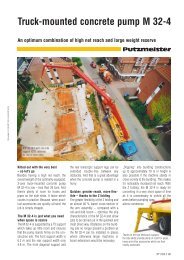
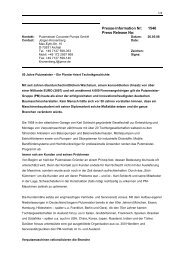
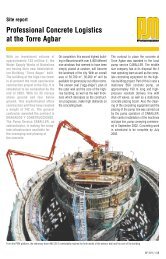
![Typenblatt CS 3095 [.pdf; 202.40 kb] - Putzmeister](https://img.yumpu.com/50530164/1/184x260/typenblatt-cs-3095-pdf-20240-kb-putzmeister.jpg?quality=85)
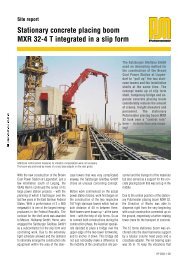
![M 47 Broşürü [.pdf; 527.92 kb] - Putzmeister](https://img.yumpu.com/49631771/1/190x141/m-47-brosuru-pdf-52792-kb-putzmeister.jpg?quality=85)

